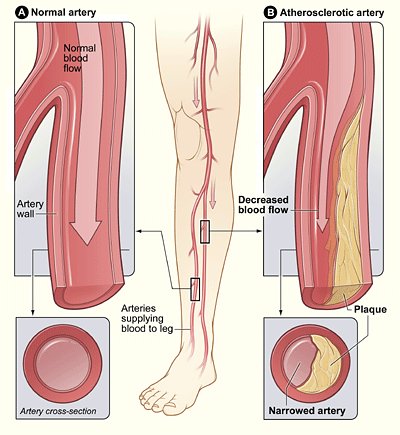What Is Peripheral Arterial Disease?
Peripheral arterial disease (PAD) occurs when a
fatty material called plaque (plak) builds up on the inside walls of the
arteries that carry blood from the heart to the head, internal organs, and
limbs. PAD is also known as atherosclerotic peripheral arterial disease.
The buildup of plaque on the artery walls is called
atherosclerosis
(ath-er-o-skler-O-sis), or hardening of the arteries. Atherosclerosis causes
the arteries to narrow or become blocked, which can reduce or block blood flow.
PAD most commonly affects blood flow to the legs.
Blocked blood flow can cause pain and numbness. It
also can increase a person's chance of getting an infection, and it can make it
difficult for the person's body to fight the infection. If severe enough,
blocked blood flow can cause tissue death (gangrene). PAD is the leading cause
of leg amputation.

The illustration shows the location
of leg arteries that can be affected by peripheral arterial disease. Figure A
shows a normal artery with normal blood flow (the inset image shows a
cross-section of the normal artery). Figure B shows an artery with plaque
buildup, which is partially blocking blood flow (the inset image shows the
degree to which the artery is blocked).
Important General Information
Atherosclerosis can affect arteries anywhere in the
body, including the arteries that carry blood to the heart and brain. When
atherosclerosis affects the arteries of the heart, it is called
coronary
artery disease (CAD). CAD can cause a
heart
attack. If atherosclerosis is in the limbs, it also is likely to be in the
coronary arteries.
When atherosclerosis affects the major arteries
supplying the brain, it is called carotid artery disease. Carotid artery
disease can cause a
stroke.
PAD (atherosclerosis in the arteries that supply
blood to the limbs, especially the legs) is a common, yet serious disease. Men
are more likely to have symptoms of PAD, but both men and women can develop the
disease. PAD can impair physical health and diminish the ability to walk.
In the advanced stages of PAD, blood flow to one or
both legs can be completely or mostly blocked. This is known as chronic
critical limb ischemia (CLI). A very severe blockage in the legs and feet means
that the legs do not receive the oxygen or nutrition needed for cellular or
skin growth and repair. CLI may lead to painful leg or foot sores, and it could
eventually lead to gangrene. If this condition is left untreated, the foot or
leg may need to be amputated.
Outlook
A person with PAD has a six to seven times greater
risk of CAD, heart attack, stroke, or transient ischemic attack ("mini stroke")
than the rest of the population. If a person has heart disease, he or she has a
1 in 3 chance of having blocked arteries in the legs. Early diagnosis and
treatment of PAD, including screening high-risk individuals, are important to
prevent disability and save lives. PAD treatment may stop the disease from
progressing and reduce the risk of heart attack, heart disease, and stroke.
Although PAD is serious, it is treatable. The
buildup of plaque in the arteries can often be stopped or reversed with dietary
changes, exercise, and efforts to lower
high
cholesterol levels and
high
blood pressure. In some patients, blood flow in the vessels may be improved
by medicines or surgery.
June 2006
|

